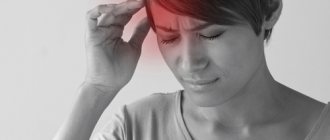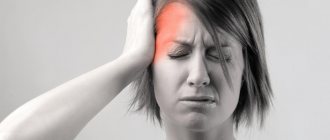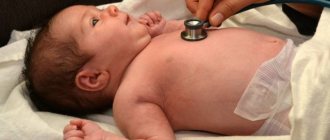Acute throbbing pain in the head on the right is a dangerous symptom that requires a more detailed diagnosis. She can talk about circulatory disorders, neoplasms, nerve damage and other diseases. It is important to understand the cause of the pain in order to choose the most effective treatment regimen. Doctors at the Clinical Brain Institute say that a throbbing headache is often the first sign of dangerous disorders and rarely occurs in a healthy person.
1. Causes of throbbing pain in the head on the right
1.1 Psychogenic headache
1.2 Migraine
1.3 Vascular diseases
1.4 Pulsating pain in the head on the right side with diseases of the ENT organs
1.5 Neuralgia
1.6 Intoxication and poisoning
1.7 Neoplasms
2. Methods for diagnosing headaches
3. Treatment methods
Why does the right side of my head hurt?
Physiological reasons
Episodic hemicranias are detected in many healthy people and disappear after taking an anesthetic, sleep, and rest. There is a connection with external circumstances and no tendency to relapse. Provoking factors are considered to be acute and prolonged stress, mental and physical overload. The right side of the head can also hurt due to alcohol intoxication, frequent smoking, or abuse of caffeine-containing drinks.
Migraine
A distinctive feature of migraine is paroxysmal unilateral pain with periodic change of half of the head. For unknown reasons, the disease most often manifests itself as pain in the right side of the head. Painful sensations are localized in the area of the eye, forehead, temple, and less often in the occipital region. They often start in one place and then cover the entire half of the head.
For most types of migraine, symptoms persist for a period of several hours to 3 days. Some signs depend on the type of disease:
- Simple migraine.
The most common. Accompanied by classic attacks without an aura, sometimes preceded by a prodrome in the form of impaired performance, deterioration of the emotional state. Nausea, vomiting, light and sound phobia are noted. - Migraine with aura.
Paroxysms are the same as in the previous case. They are preceded by an aura, which is most often represented by visual disturbances. There may be unusual sounds and smells, sensory disturbances, and difficulty speaking. - Vestibular migraine.
A typical feature is dizziness, which occurs at the prodrome stage and may persist or disappear with the onset of the headache. Sometimes different variants of the aura are observed. - Ocular migraine.
Along with visual disturbances (flickering, the appearance of scotomas, loss of parts of the visual field) that precede cephalalgia and persist for 10-20 minutes, this type of migraine differs from others in its atypical duration - less than 3 hours. - Ophthalmoplegic migraine.
Another variant of the disease with ophthalmological disorders and unusual duration. Symptoms persist for more than a week. Disturbances from the oculomotor, and less commonly, trochlear or abducens nerves occur on days 1-4. Diplopia, mydriasis, strabismus, and drooping eyelids are possible.
If the duration of a migraine attack (except for types with ocular symptoms) is more than 3 days or paroxysms during this time continuously occur one after another, migraine status is diagnosed. This condition is characterized by high pain intensity, wave-like decrease and increase in symptoms, and progressive dehydration caused by repeated vomiting.
Paroxysmal hemicrania
It occurs with episodes of extremely intense pain in the right or left half of the head with the epicenter in the orbit, temporal zone, crown, back of the head, and forehead. It can be provoked by sudden turns of the head, drinking alcohol, or strong emotions. Pain sensations are stabbing, boring, burning, pulsating, aching. The duration of the episode is 5-45 minutes; in severe cases, up to 40 attacks occur during the day. Paroxysmal hemicrania is accompanied by autonomic disorders: lacrimation, local hyperhidrosis, feeling of heat, nasal congestion.
Pain in the right side of the head
Hypnic headache
This primary cephalgia is characterized by its occurrence only during sleep. Separately, the right or left half of the head is affected in 40% of patients; in other cases, the pain is bilateral. At the beginning of the attack, the patient awakens, after the end of the paroxysm he falls asleep again. Hypnic headache is dull, moderate, rarely severe. Diagnosed in people of the older age group, once it appears, it continues to bother throughout life.
Cluster headache
Unlike migraines, the left side of the head is affected more often than the right, but right-sided cephalgia is also possible. The majority of patients are young men. Attacks of cluster headaches develop suddenly, increase within 1-3 minutes, and stop after 15-120 minutes. The painful sensations are extremely intense. Localized mainly in the orbital area, stabbing, burning, tearing, pressing. They decrease with moderate physical activity, so during paroxysm patients constantly move.
Vertebrobasilar insufficiency
Pain in half of the head is typical for the spondylogenic form of the disease. The left and right halves are affected equally often, the localization is determined by the side on which blood flow disturbances occur in the vertebral artery. The pain is provoked by movements of the neck, its severity clearly depends on the position of the head. Painful sensations with vertebrobasilar insufficiency appear in the back of the head, cover the temple, forehead, orbit, and radiate to the upper limb. Accompanied by autonomic and cerebellar disorders, visual and hearing disorders.
Other cerebral pathologies
Pain in the right side of the head is observed with brain tumors, limited arachnoiditis of the corresponding localization. With neoplasms, it appears in the early stages of the disease, strong or moderate, bursting, deep, often observed in the form of attacks. With arachnoiditis, it occurs chronically, gradually progresses, worries mainly in the morning, and is supplemented by neurosis-like symptoms.
Other reasons
Right-sided cephalgia can be detected in the following diseases:
- Sinusitis.
The pain syndrome is bursting, pulsating, provoked by sinusitis or sinusitis of the right paranasal sinuses. It is more pronounced in the forehead area, extending to the temple. Nasal discharge and general signs of an inflammatory process are characteristic. - Mastoiditis.
Manifests simultaneously with acute purulent otitis media or a few days after its onset. There is intense pain behind the ear, spreading to adjacent parts of the head, increased temperature, and drainage of pus from the ear. - Temporal arteritis.
Rheumatic pathology is caused by damage to the temporal artery and is accompanied by throbbing, dull pain in the temple. The pain intensifies at night and gradually progresses. Combined with general intoxication manifestations. - Spinal diseases.
Pain in the right side of the head is caused by right-sided compression of nerves and blood vessels. It is detected in patients with osteochondrosis and intervertebral hernia. Neck pain is typical and gets worse with movement. Possible muscle weakness, numbness of the right hand.
Causes of throbbing pain in the head on the right
Throbbing pain in the right side of the head is not a disease, but a symptom of a number of diseases. In rare cases, it can occur in a healthy person, and it can be very intense. However, it is important to undergo a full examination, since more often it indicates diseases of blood vessels and nerves, neoplasms and other dangerous disorders.
Psychogenic headache
One of the causes of throbbing pain in the right side of the head is nervous tension, stress and high mental stress. A separate category is psychogenic headache, which accompanies various mental disorders:
- with neurasthenia, the headache can be throbbing, pressing, occur only in the left or right side, or spread over the entire surface;
- with hysteria this is a rare symptom; patients find it difficult to indicate the exact location of the painful area;
- depression, hypochondria - with these diseases, an acute, throbbing headache manifests itself when exposed to a traumatic factor.
Psychogenic headaches can be relieved with painkillers or non-steroidal anti-inflammatory drugs. It goes away completely after successful treatment of the underlying disease, as well as during periods of remission.
Migraine
Unilateral throbbing pain in the head on the right side is a typical symptom of migraine. The disease is manifested by attacks of pain that occur for no apparent reason. Its exact cause is unknown, but the role of impaired cerebral blood flow has been proven. Changes in pressure and deterioration in blood movement through the vessels lead to the manifestation of a classic migraine - a one-sided throbbing headache.
Before the onset of an attack, a migraine “aura” often develops. This is a set of symptoms that can be used to determine the imminent deterioration of well-being. These include sensitivity to light and smells, increased activity, or emotional depression. The following factors can trigger an attack:
- sharp sounds, smells, bright lighting;
- violation of sleep patterns, physical activity and nutrition (fasting);
- some products, often sweets;
- changes in weather conditions;
- stress, emotional tension.
If the headache is moderate, it goes away after proper rest. At home, you can take anti-inflammatory and painkillers (Ibuprofen, Spazmalgon). Your doctor may also recommend specific anti-migraine medications (Sumatriptan).
Vascular diseases
Arteritis is a group of diseases that are manifested by inflammation of the walls of the arteries. They can be infectious or non-infectious in origin, and most often occur in old age. If the disease affects the vessels of the head, it is accompanied by acute, throbbing pain in the head on the right or left side. In some patients, lumps may be felt on the temples - nodules that are located in inflamed areas.
Treatment of arteritis is carried out under the supervision of a physician. According to indications, the following groups of drugs may be prescribed:
- medications that stimulate blood circulation (Pentoxifylline);
- to restore the vascular wall (Actovegin);
- antispasmodics (Spazmalgon, No-Shpa);
- non-hormonal and steroidal (Prednisolone) anti-inflammatory drugs - the latter can only be taken with a doctor's prescription.
Arteritis requires timely treatment, otherwise it can progress and pose a threat to the patient’s life. Additional symptoms appear, including changes in scalp sensitivity, blurred vision, and increased body temperature. Inflammation of the vessels of the head can develop simultaneously with venous diseases (phlebitis, thrombophlebitis) and pathologies of the heart vessels.
Throbbing pain in the head on the right side with diseases of the ENT organs
If the pain throbs in the head on the right, this may be a sign of diseases of the ENT organs. They cause mechanical compression of blood vessels, swelling, and the spread of infection through the bloodstream is also possible. There are several pathologies that are characterized by the appearance of an acute, throbbing, unilateral headache.
- Inflammation of the nasal sinuses (sinusitis, sinusitis) is a chronic disease in which exudate accumulates in the cavities of the paranasal sinuses. If normally they are empty, then with sinusitis they are filled with liquid or viscous contents. Swelling of the mucous membrane and difficulty breathing are also observed.
- Otitis is an inflammation of the ear. Especially dangerous is purulent internal otitis, which is characterized by acute pain and the danger of infection spreading to the membranes of the brain.
- Injuries or neoplasms of the hearing organs are the cause of constant intense headaches. It appears only on the affected side, covering the ear and temple area.
Treatment is prescribed individually. In different cases, broad-spectrum antibiotics, anti-inflammatory and painkillers are used. Surgical intervention may also be required: puncture of the nasal sinuses to extract contents, removal of tumors.
Neuralgia
Pain that pulsates from the right side of the head is a characteristic sign of neuralgia. It represents acute pain due to inflammation or damage to the nerves. Acute attacks are short-lived and rarely exceed 30–60 seconds, but are highly intense. They appear suddenly and pass quickly; the rest of the time a nagging headache may persist. It is one-sided, but over time it can cover the entire surface of the head.
Trigeminal neuralgia is more common. It originates from the 5th pair of cranial nerves and is divided into 3 branches: the orbital, maxillary and mandibular nerves. They innervate the dura mater of the brain, soft tissues of the cranial vault, as well as skin, muscles and mucous membranes. Its inflammation is accompanied by a throbbing headache, often one-sided, temporary blurred vision, and impaired sensitivity of the facial skin. Treatment takes place only under the supervision of a doctor. The regimen includes painkillers and anti-inflammatory drugs, novocaine blockades, anticonvulsants and other drugs.
Intoxication and poisoning
Acute headache is one of the first signs of intoxication. Poisoning can be caused by solid, liquid or volatile substances that enter the body with inhaled air or through the digestive tract. These include heavy metals, mercury, alcohol, carbon monoxide and other compounds. The products of their metabolism accumulate in the tissues of the nervous system and provoke an acute, throbbing headache. Additional symptoms also appear:
- increased blood pressure;
- pulsation in temples;
- noise in ears;
- nausea and vomiting;
- cardiopalmus.
At the first signs of poisoning, you should consult a doctor, otherwise the symptoms may progress. In later stages, the patient experiences convulsions, breathing problems and pulmonary edema. To relieve intoxication, it is important to restore the balance of fluids and electrolytes (droppers); if possible, an antidote is used, which reduces the harmful effects of the toxic substance and reduces the concentration of toxins in the blood.
Neoplasms
For unilateral headaches, it is important to exclude the possibility of tumors. They vary in shape and size and can be benign or malignant. Some of them do not grow, others can reach large sizes over time. It is necessary to determine the size of the tumor, its type and histological features, as well as its tendency to growth and malignancy. Based on these data, the doctor makes a decision on the treatment regimen.
In the initial stages, tumors may not show any signs. Some patients complain of a constant headache concentrated in a certain area. Symptoms depend on the exact location of the tumor and its size. A typical clinical picture may include persistent nausea, impaired hearing, vision and coordination of movements, and mental disorders.
Diagnostics
Determining the pathology that causes pain in the right side of the head is the responsibility of a neurologist. If necessary, the patient is referred for consultation to an otolaryngologist, rheumatologist, or oncologist. To identify focal symptoms, a neurological examination is performed. Diagnosis of primary cephalgia is based on compliance of the clinical picture of the disease with certain criteria. Additional techniques are used during differential diagnosis. For other pathologies, the list of procedures is determined taking into account the nature of the disease. May be assigned:
- Ultrasonography.
Duplex and Doppler sonography are informative in assessing the condition of blood vessels. In case of vertebrobasilar insufficiency, they are performed to study the cervical and intracranial vessels, determine the localization and extent of stenosis. In other cases, they are prescribed to exclude vascular diseases. - Tomography.
Patients with arachnoiditis and tumors are referred for MRI of the brain. If the vertebral artery is damaged, MR angiography is performed. Spinal diseases are diagnosed using CT or MRI of the cervical spine. - Otolaryngological examination.
Necessary for sinusitis, mastoiditis. Along with an external examination, anterior rhinoscopy, otoscopy, and diagnostic puncture of the accessory sinus can be performed. - Radiography.
Images of the cervical spine are recommended for disc herniation, osteochondrosis, and suspected compression of the vertebral artery by surrounding hard structures. X-rays of the temporal bone are indicated for mastoiditis, and of the paranasal sinuses for sinusitis.
Electroencephalography
Treatment
Conservative therapy
The treatment plan is drawn up taking into account the nature of the disease. The following medications and non-drug methods are used:
- Migraine.
To eliminate paroxysms, non-narcotic analgesics are prescribed. For persistent attacks, blockades are performed. For intense excruciating pain and migraine status, triptans are used in tablets, rectal suppositories, and solutions for parenteral administration. The last two options allow you to solve the problem of taking the drug for persistent vomiting. - Paroxysmal hemicrania.
NSAIDs, glucocorticosteroids, and calcium channel blockers are effective. Depending on the severity of the pathology, medications are taken in short courses or continuously. - Cluster headache.
Painful attacks are eliminated with the help of triptans and applications of local anesthetics to the nasal mucosa. The effectiveness of inhalation of 100% oxygen is noted. Preventive measures in the interictal period are carried out using calcium channel blockers, hormonal, and antiepileptic medications. - Hypnic headache.
The basis of treatment is hypnotics, lithium preparations, and atypical benzodiazepines. Some researchers have reported the effectiveness of steroids and NSAIDs. Before going to bed, patients are advised to take caffeine-containing and melatonin-containing medications. - Vertebrobasilar insufficiency.
Antiplatelet agents, anticoagulants, neuroprotectors, antihypertensive, vascular drugs, exercise therapy, massage, manual therapy, hyperbaric oxygenation, magnetic therapy, laser therapy are recommended. - Tumors.
To reduce the severity of symptoms, non-narcotic and narcotic analgesics, antiemetics, glucocorticoids, and psychotropic drugs are used. Radiation and chemotherapy are carried out as part of palliative therapy or are part of complex treatment in the pre- and postoperative period. - Spinal pathologies.
Pain is eliminated with the help of oral and parenteral forms of NSAIDs, muscle relaxants, and local administration of glucocorticosteroids. They use B vitamins, neurometabolites, phonophoresis, UHF, electrophoresis, and magnetic therapy. - ENT diseases.
Treatment regimens include antibacterial, vasoconstrictor, antihistamines, physiotherapy, paracentesis of the tympanic membrane, and puncture of the paranasal sinuses.
Surgery
Treatment of primary cephalgia is only conservative. For other pathologies, the following may be indicated:
- Vertebrobasilar insufficiency
: reconstructive surgery to restore blood flow. - Brain neoplasia
: removal of cerebral tumors using traditional and minimally invasive surgical techniques. - Spinal diseases
: low-traumatic (endoscopic microdiscectomy, puncture laser vaporization) and traditional (discectomy) interventions for hernias, sometimes in combination with fixation operations. - Pathologies of ENT organs
: sanitizing surgery, mastoidotomy, frontotomy, maxillary sinusotomy, micromaxillary sinusotomy.
Treatment methods
A headache attack can be relieved at home. The main recommendations of doctors are rest and proper sleep, a normalized regime of physical activity and proper nutrition. Acute pain goes away after taking painkillers and antispasmodics. If there is no reaction to taking these drugs, you should immediately consult a doctor. At the Clinical Institute of the Brain, treatment is carried out both on an outpatient basis and in a hospital setting, with constant supervision by doctors. An individual treatment regimen may include the following steps:
- drug treatment - anti-inflammatory drugs, vitamins, means to strengthen blood vessels and improve the functioning of the cardiovascular system;
- surgical methods - removal of tumors, aneurysms, blood clots and other neoplasms that compress brain tissue and cause ischemia;
- additional techniques (physiotherapy, massage) are used to relieve pain and improve the transmission of nerve impulses;
- specific drugs that are used for intoxication, treatment of tumors, autoimmune and other diseases.
The Clinical Brain Institute specializes in the diagnosis and treatment of diseases that manifest as unilateral throbbing headaches. Competent specialists will select the optimal treatment regimen, thanks to which it is possible to either achieve complete recovery or stop the symptoms of the disease and stabilize the patient’s condition. Doctors strongly recommend not to endure an acute headache, which occurs frequently and is highly intense - early diagnosis will allow you to identify the disease in the initial stages and begin treatment in a timely manner.








